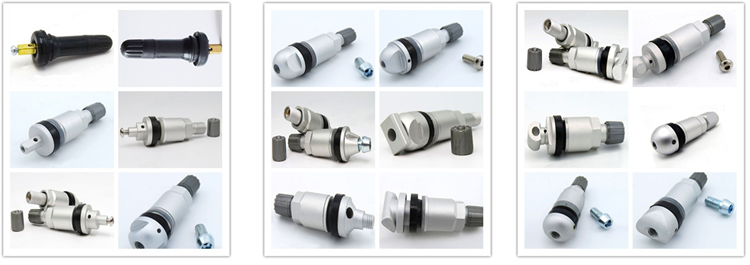Tire Valve Stem With Sensor
Functions and effects
A tire valve stem with a sensor refers to a tire valve stem integrated with a sensor, typically used in a vehicle's Tire Pressure Monitoring System (TPMS). Below is a detailed introduction to it:

Functions and Roles
- Real-time Tire Pressure Monitoring
It can measure the air pressure inside the tire in real time and transmit the data to the vehicle's control system or the driver, allowing the driver to stay informed about the tire pressure status at all times. This helps detect issues such as low/high pressure or air leakage promptly. For example, low tire pressure increases the tire's contact area with the ground, enhancing friction and causing excessive tire wear, which may lead to tire overheating or even a blowout. High pressure reduces tire elasticity and grip, affecting vehicle handling. - Prevention of Safety Accidents
Maintaining normal tire pressure helps avoid dangerous situations like vehicle loss of control or blowouts caused by abnormal tire pressure, improving driving safety. - Improvement of Fuel Efficiency
Proper tire pressure reduces tire rolling resistance, lowering vehicle fuel consumption. Statistically, for every 10% drop in tire pressure below the standard value, fuel consumption increases by about 1.5%. Real-time monitoring via a sensor-equipped valve stem helps save fuel costs and reduce emissions. - Extension of Tire Lifespan
Normal tire pressure ensures uniform tire wear, reducing local excessive wear and extending tire life by 10%-20% compared to tires with abnormal pressure.
Working Principle
- Direct TPMS
For a tire valve stem with a sensor using this system, a pressure sensor and a wireless transmitter module are usually installed inside the valve stem. The pressure sensor detects changes in tire pressure and temperature, converts these physical quantities into electrical signals, which are then transmitted by the wireless module to the vehicle's receiver at a specific frequency. The receiver processes and analyzes the signals, displaying the pressure and temperature data of each tire on the dashboard or display screen. - Indirect TPMS
This system's sensor-equipped valve stem monitors tire pressure by comparing speed differences between tires. When a tire's pressure drops, its rolling radius decreases, making it rotate faster than other tires. The vehicle's ABS wheel speed sensors detect this difference, determine abnormal tire pressure, and trigger an alarm.
Types and Characteristics
- Classification by Installation Method
- Snap-in Type
Fixed in the mounting hole on the rim edge via a snap ring or clamp, it is relatively easy to install and remove, suitable for various rim types. This type usually has good sealing and stability, capable of withstanding certain lateral forces. - Adhesive Type
Fixed on the rim surface with strong glue or double-sided tape, it is simple to install and does not damage the rim. However, the adhesion may be affected by ambient temperature and humidity. In high-temperature or humid environments, the glue's viscosity may decrease, causing the valve stem to fall off.
- Snap-in Type
- Classification by Material
- Rubber Material
It has good elasticity and sealing performance, adapting to tire deformation and vibration, and is relatively low-cost. However, its high-temperature and aging resistance is poor, and long-term use may cause cracking or hardening, affecting the sensor's normal operation. - Metal Material
Such as copper, aluminum, or stainless steel, it has high strength and corrosion resistance, can withstand high pressure and temperature, and has a long service life. However, metal valve stems are relatively heavy, which may affect tire dynamic balance, and they are more expensive than rubber ones.
- Rubber Material


